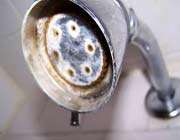How to Remove Water Stains

If you have hard water in the home, it means that your H2O contains large amounts of minerals, such as limestone, calcium, and magnesium. It's perfectly safe to use but it can have some pretty serious consequences on your house over time. A more serious problem is lime scale buildup which will eventually develop in your plumbing and impede proper water flow. But mineral-enriched water can also cause smaller troubles around the home: hard water stains. Whatever it touches can begin to spot and tarnish, including dishes, glasses, clothes, toilets, showers, sinks, and even your car. So it's always a good idea to invest in hard water stain removal early on before it wreaks havoc on your entire house.
Beware of the Blemishes
Since we use most of our water in the bathroom, hard water stains often occur on showers, tubs, and sinks. Typically it appears as a thin film of rough powder on various surfaces (especially glass, plastic, and porcelain) since mineral-based water has a difficult time dissolving soap. However, it can become more serious when metal is involved. If the moisture has high iron content, it can leave behind a red tinted slime. Brass or copper fixtures could develop blue-green rust due to acidic ingredients in your water supply. But the problem doesn't just involve your bathroom: if your water can't get the soap out, it can also develop on your dishes, clothes, and eventually clog your appliances.
The Basics of Removing Lime Stains
Lemon Juice – Lemon juice works like vinegar because it has chemicals in it that are in line with the principles on how white vinegar works. You can simply cut the lemon in half, and then scrub the fruit on the stain. You can also use the juice of the lemon to wipe the lime stain off surfaces.
Lemon juice has acetic acid that cuts through the stain, especially the soap scum, which explains how the organic compounds in your kitchen sinks and bathroom are dissolved. It is also important to rinse thoroughly to make sure that after dissolving the lime stains, you get rid of them completely. Leave no residue behind. Make it a point to clean the affected surfaces on a regular basis, to make sure that the lime stains won't be back anytime soon.
Vinegar – Vinegar is acidic, so there's no doubt that it can help you get rid of lime stains. If not, then lemon juice will be just as good. Simply rub any of these two solutions over the lime stain. You can soak a brush with the lime juice or the vinegar to rub the stain more effectively. The acid content of the vinegar or the lime juice will dissolve the lime stain. Vinegar not only helps you get rid of lime stains, but also helps you clean garbage disposals, dishwashers and coffee makers.
Bleaching – To make effective use of this method, it is important to use bleach and choose the right brush. You will have to use bronze brush to make sure that the tough lime stains are wiped off the affected areas. Bleach is an effective solution to getting rid of lime stains because it can whiten surfaces. It can remove color through oxidation. Oxygen bleach contains compounds that release peroxide, like sodium percarbonate or sodium perborate.
You can also use chlorine bleach, which has about 3-6% NaOCl (sodium hypochlorite). Your dentist uses this on you when you go for a root canal treatment. It is used in endodontics because it can disinfect the canal in a tooth. It can also dissolve whatever pulp tissue is left. It follows that it can also dissolve hard water build up in pans, pots, sinks and bathrooms.
Rhubarb – Rhubarb is a type of perennial plant which can be spotted developing from thick and short rhizomes. It has a large triangle leaf with fleshy petioles. You can find rhubarb in grocery shops. When you boil it, you release its absorbic acid which is natural in the plant. You can use it to clean lime stains. After cleaning your lime stains with rhubarb, dispose of the plant waste properly. Clean the formerly-affected area thoroughly.
Scrubs -- Scrub the affected area to remove soap scum and dirt. Use warm tap water for wiping off all the filth in the spot. After this, wipe the area with a dry cloth or an absorbent towel. It is more difficult to remove lime stain if you are also removing soap scum and dirt. If you wipe off the soap scum and dirt, you are dealing with the whole stain layer by layer. This is indeed an easier and more effective way to get rid of stain.
Ammonia – Ammonia can also work wonders for your sinks and pans, but this is only true if you do not use this together with bleach. You cannot mix ammonia and bleach together because toxic fumes may form.
If you have tried all these and none of them worked, then try using stronger solutions and more harsh acids. To get the clearer picture, you can, for example, use oxalic acid to clean lime stains off the affected surfaces inside your house. Oxalic acid is considered a stronger acid than any of the ones mentioned above because it can remove rust. Phosphoric acid is also another option when all else fails, since you can find this acid in cleaning items that help you get rid of hard water deposits. Sulfuric acid and hydrochloric acid can also be considered since these are ingredients found in diluted concentrations used to manage dirt in toilet bowls.
Sources:
homeadvisor.com
howtogetridofstuff.com
Other links:
How to Prevent Onions From Making You Cry